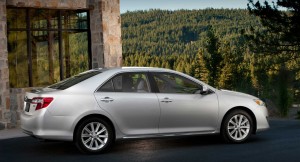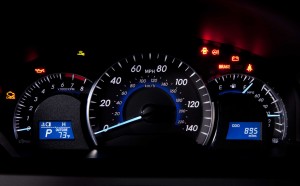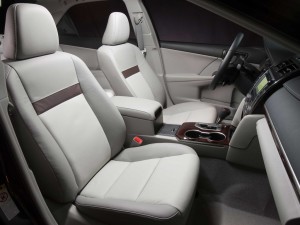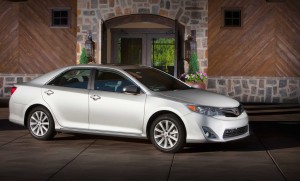
The Toyota Camry has been the best-selling car in the U.S. for 13 of the last 14 years. Has Toyota done enough for it to keep its crown?
Updating the best-selling of anything is fraught with peril, whether it is a car or a hammer. There’s a reason its maker sells so many, so you don’t want to get too crazy. But the competition is looking to take away that sales crown, so standing pat isn’t an option.
Such is Toyota’s task with its best-selling Camry. While the new car offers the usual increases in efficiency and interior space, Toyota smartly decided to leave the Camry similar to the outgoing model.
While the new Camry doesn’t do much to break new ground, Toyota did make a few changes.
Let’s take a look to see if they were successful.
The styling is familiar. More streamlined and smoother, the Camry gives up its busy rear decklid – surprisingly, just as Chevrolet has gone in that direction. But similar to the Chevy, Toyota has decided to keep with a more conservative look, leaving the Ford Fusion, Kia Optima and Hyundai Sonata to lead the styling revolution in mid-sizers.
It’s not surprising since the long-held belief is that buyers in this segment prefer conservative styling.
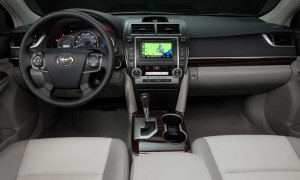
The Camry interior has excellent ergonomics, even if the design doesn't quite have the fluidity of some other new designs.
The conservative look continues inside where the Camry looks like it’s taken lessons from its more expensive siblings over at Lexus. In keeping with current styling trends, the new design is more intricate and more sophisticated.
What was a little surprising was the way the Camry – an XLE, not the sporty SE – drove. The supple ride and quiet cruising weren’t unexpected, but what was a little shocking was how much fun it was to drive.
Equipped with the optional 268-horsepower V-6, this Camry is seriously quick, hitting 60 in less than six seconds. There’s quite a bit of body roll. But while it’s no sports sedan, the Camry willingly goes after corners.
About the only criticism of the way it drives is the light steering, which gets even lighter when accelerating hard as the car unloads its front wheels.
But that V-6 is a sweetheart. It goes about its business quietly and smoothly. That is until you give it a kick and wind it past 5,000 rpm and near its 6,200 rpm torque peak where its character changes from mild-mannered to caged tiger. It even sounds a little sexy. This is a Camry?
Toyota reduced internal friction in the corporate 3.5-liter V-6, using lower-viscosity oil to help improve efficiency. With the V-6, the Camry is rated at 21 city and 30 highway. We saw 27 on mostly freeways and rural two-lanes.
The standard engine is a 2.5-liter four cylinder that makes 169 horsepower. The sport SE gets an additional 10 horses with the four cylinder, but the V-6 stays at 268. Unfortunately, a manual transmission is no longer available in the SE.
Toyota continues to lag in use of direct injection, which other automakers – notably General Motors, Ford and Hyundai/Kia – are using to provide greater efficiency.
For example, the standard engine in the Kia Optima and Hyundai Sonata is a 2.4-liter four cylinder, making 198 horsepower, 29 more than the base Camry. And despite the horsepower advantage, it still gets better fuel economy, with ratings of 22 city and 35 highway compared to as high as 22-33 for the four-cylinder Camry.
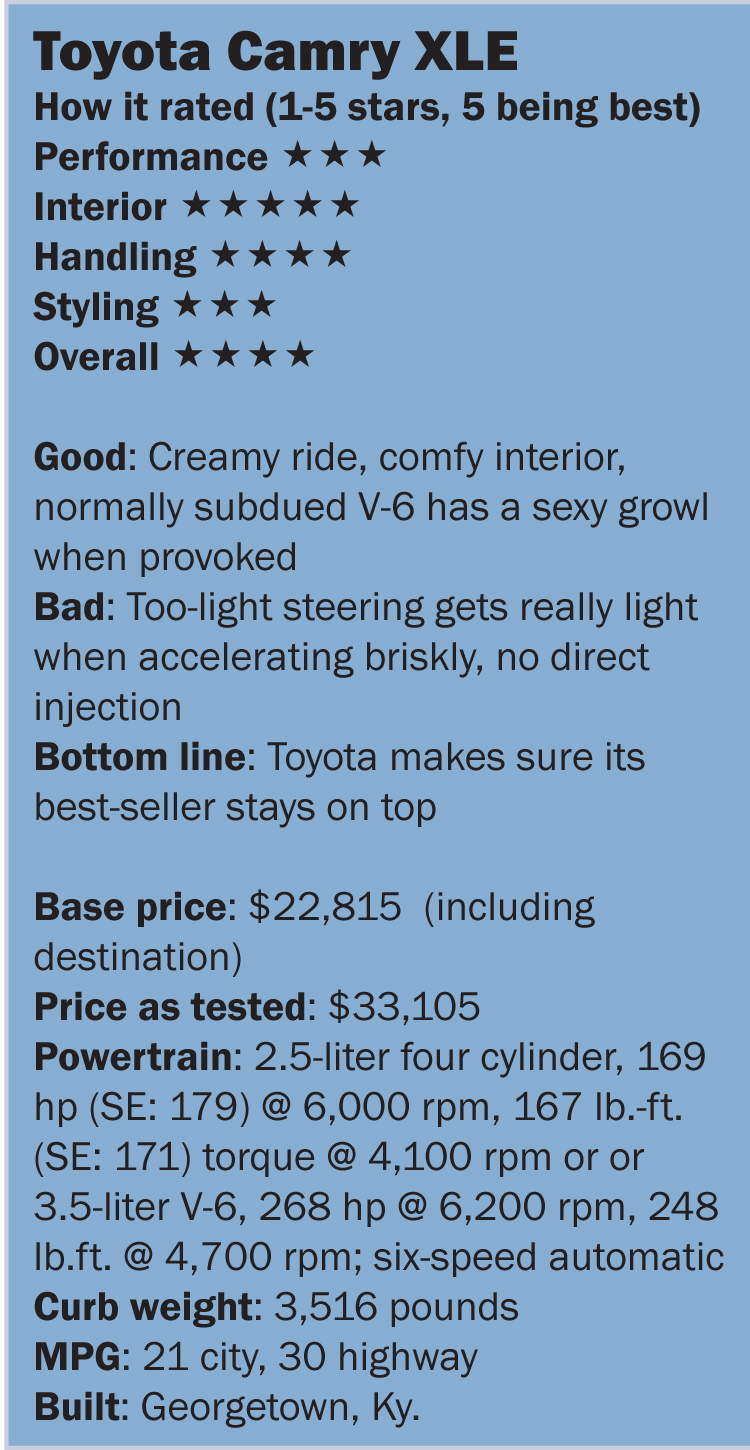 One of the major movements in this segment is the replacement of V-6s with turbocharged fours. The Kia and Hyundai offer a 2.0-liter turbo making 274 horsepower and offering performance that is similar to the Camry V-6. While the Camry’s V-6 is smoother than Korean automakers’ engine, it can’t match it in fuel economy, with the Korean twins rated at 22/34.
One of the major movements in this segment is the replacement of V-6s with turbocharged fours. The Kia and Hyundai offer a 2.0-liter turbo making 274 horsepower and offering performance that is similar to the Camry V-6. While the Camry’s V-6 is smoother than Korean automakers’ engine, it can’t match it in fuel economy, with the Korean twins rated at 22/34.
This well-equipped XLE had a very pleasant interior with stitched dash material that looks like leather and a center stack that looks like it’s floating above the dash.
As seems to be the norm in cars in uplevel trim cars in this price class, the XLE has plasticky fake wood trim that doesn’t look much like wood. It’s no worse than just about every other car that uses trim like this, so maybe we should just stop complaining about it.
There’s a big, covered cubbie ahead of the cupholders and a smaller one behind them, so you’ll have lots of room to stash your phone, music player, even an oversized sunglasses case. The wide armrest on the center console is nicely padded.
Toyota’s Entune system works well. It offers a variety of apps such as sports scores and weather, although we were never able to see any actual weather on the weather map – even during a downpour. Voice recognition – which is always better in cars with quiet interiors – was good.
The wide seats are long-haul comfortable, though they’re not really up to spirited driving. Spaciousness is the order of the day in the Camry. Rear-seat passengers get expansive kneeroom and good headroom. No coupe-like profile cutting into rear-seat comfort here.
Camrys start at $22,815 for the base L. The XLE V-6 tested here starts at $30,875. Blind Spot Monitor adds $500 and Safety Connect – including emergency assistance, stolen vehicle locator, automatic collision notification (available by subscription after one-year trial) adds $450 and navigation with Entune voice recognition and JBL audio costs $1,550, bringing the as-tested price to $33,105.
The Toyota is a joy and with the V-6, can be somewhat fun. But the competition’s high-tech fuel-economy tricks could trump the Japanese master.
3,516

